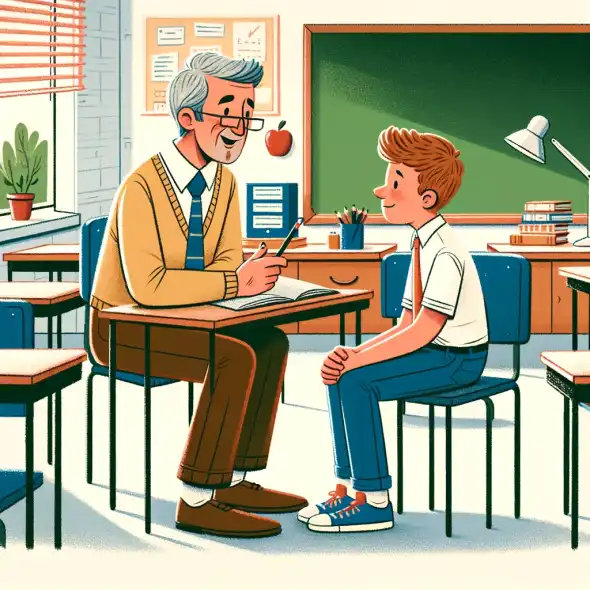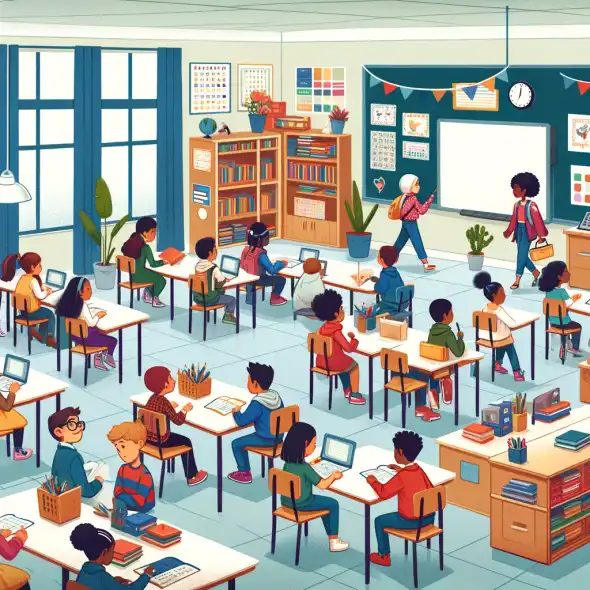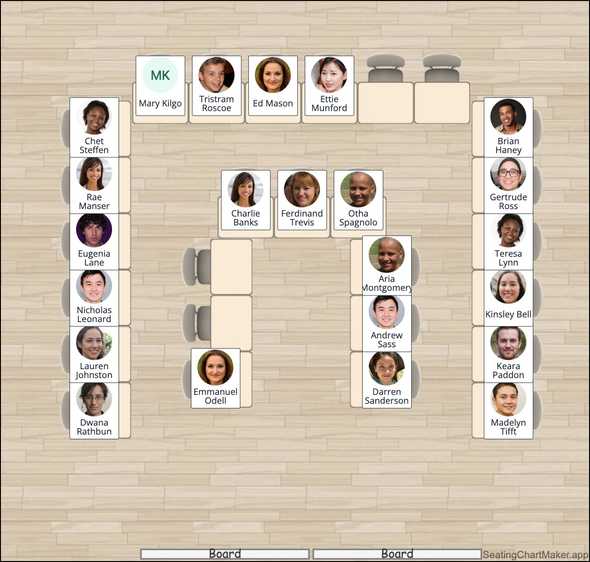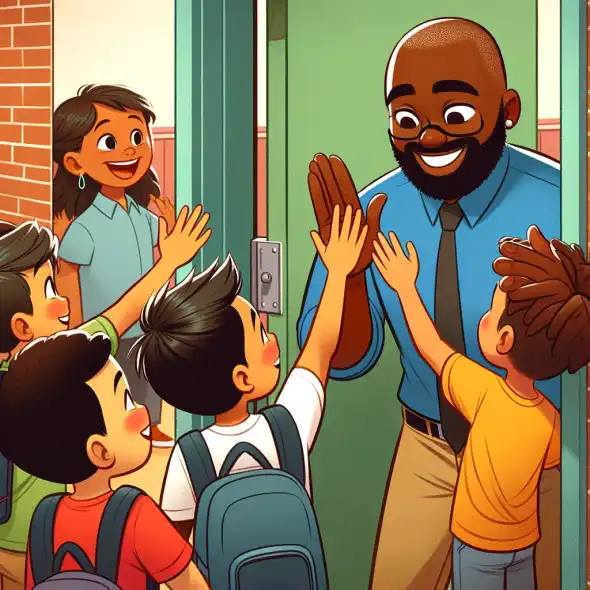Classroom Management Strategies: The Ultimate Teacher’s Guide

Do you remember when you first started studying to be a teacher? You put in crazy long hours learning everything there was to know about your subject area, and you tirelessly practiced the art of teaching in a classroom full of your peers. From designing the perfect lesson plans to giving the perfect presentations and gracefully receiving the perfect feedback, you had a clear vision for what your perfect classroom would look like someday.
And then you entered the real world of teaching. And suddenly, you realized something quite profound.
There is no such thing as the perfect classroom, with the perfect students, sitting in perfect little rows, exhibiting perfect behaviors, and giving only perfect answers to every single question you ask just like magic.
Instead, a good class for a first-year teacher looks more like organized chaos than anything else. But, that first year also shapes you in ways you never thought possible. And you realize that no matter how many years of teaching you have under your belt, you’ll always be experiencing, learning, and growing in your profession just like you were that very first year.
The fact is, you’re bound to come across situations over the years that no textbook, college professor, study session, or student teaching experience can ever adequately prepare you for. And that is entirely okay. In fact, it’s expected.
The beauty of being a teacher is that you learn to be patient, flexible, and evolving with the help of your students. When you do those things, you become the perfect teacher for those perfect students, just like you once imagined—even though none of you are really all that perfect.
Thankfully, this entire evolutionary process doesn’t have to be nearly as difficult as it sounds.
With the help of experienced teachers, a little creativity, and a whole lot of patience and flexibility, you can create a safe, secure, and welcoming classroom environment for your students and for yourself. The only secret you need is to develop a classroom management strategy that works.
To help you get started, we’ve researched the very best classroom management tips and tricks out there and created the ultimate guide for all teachers to use in their real-world classrooms. Each of these classroom management tips and tricks on our list has been vetted by teachers just like you who want to provide the very best classroom experience for each of their students.
1. Build Rapport
Building rapport with each of your students individually is the most important thing you can do as part of your overall classroom management strategy. Relationships matter, and each of your students deserves to feel like you care about them as a person. They’ll behave better when they start to feel like you truly get them. Plus, they’ll work harder in class because they want you to be proud of them. No matter how aloof they may seem, students want and need to have a positive relationship with you to do their best.
2. Give Respect to Get Respect
Part of relationship building is giving and getting respect. Your students are still young people who really need a strong role model in their lives to show them how positive relationships work. As a teacher, you deserve to be respected. And the best way to get respect in return is by giving it to your students first. So, be sure to speak to your students in a calm voice, use appropriate language, and be kind.
3. Establish Routines
Students crave routine. Knowing what to expect helps them feel safe and secure, and it alleviates a lot of anxiety that comes from the unknown. Things as simple as knowing where to turn in assignments, the acceptable time for pencil sharpening, and how to check out books from your classroom library are all routines you should establish early on in the school year and practice as often as possible. Doing so is a big part of classroom management because it provides structure and eliminates chaos. Check out the many reasons routines are so important to kids.
4. Get Student Input
Another important aspect of classroom management is setting clear expectations for your classroom. But, getting student input on what those rules should be really takes your classroom management strategy to a whole new level. When kids feel invested in something, they’re more likely to take it seriously and hold themselves accountable. So, let them help you establish classroom expectations at the beginning of each school year and revisit them as often as needed.
5. Have Clear Consequences
In order to have good classroom management, you really need to have clear consequences established for each undesirable behavior you may come across during the day. If you let too many things go, your students will take advantage of you and continue to act out, so it’s important to make them aware of the expectations and what will happen if they are not met. Kids hate surprises. Make your consequences clear from the get-go. For example, let students know that if they leave their seats before the bell rings, they will have to return to their seats until everyone else leaves.
6. Model Expectations
Students don’t always misbehave just because they feel like it. Sometimes they act up simply because they don’t understand what it is that you are looking for or they haven’t had enough practice behaving the way you want them to. Remember, your students come from a variety of different backgrounds with a host of behavior expectations at home, so it’s important to model expectations for them so that they’ll learn to imitate your good behaviors over time. For example, you can demonstrate raising your hand and waiting patiently to be called on. While there isn’t a lot of evidence behind it, leading by example is a well-known concept that many educators use in their classrooms.
7. Plan the Perfect Classroom Setup
Believe it or not, your classroom setup makes a big difference in how students behave in class. Placing students in rows will elicit a very different response than placing them in small groups, large groups, herringbone, or u-shaped seating arrangements. What works for one class, may not work for the next. So, experiment until you find the perfect classroom set up for your students this year. And don’t be afraid to set up alternate seating options throughout your classroom as well. Check my full list of arrangement options from this post.
8. Create Intentional Seating Charts
Seating charts are another classroom management strategy that actually works. As a teacher, you learn very quickly that some students work well together while others clearly do not. That’s why taking the time to create a very intentional seating chart for each of your classes helps you keep things under control. Plus, it allows you to group students any way you like in order to maximize their learning potential by keeping them focused and collaborating with peers with similar ability levels.
9. Design a Rewards System
Kids love rewards, and they’ll do just about anything to earn them. That’s why setting up a rewards system in your class is a great way to encourage positive behaviors and discourage negative ones. And you certainly don’t have to spend a lot of your hard-earned cash doing so. Get creative! Allow the winner in your class to pick a movie to watch just before a holiday break or choose which music to listen to during earned free time.
10. Be Consistent
Nothing ruins the vibe in your classroom faster than being inconsistent with procedures, expectations, and consequences. Your students will pick up on it if you allow certain behaviors one day but you don’t the next. And they will gladly call you out on it. Consistency is key to good classroom management because students feel safest when they know what to expect. For instance, if you don’t allow students to touch anything on your desk, you can’t let it go some days and not others. So, set your rules and stick to them. Doing so shows your students that you’re firm but fair.
11. Greet Students Every Day
Want your students to behave well, give you their best effort, and feel heard? Greet them at the door every day. A simple hello accompanied by a warm smile lets each of your students know that you see them and that they matter to you. Even if their day has not been going well so far, you can turn things around for them with a positive attitude and a word of kindness.
12. Communicate Daily Schedule
Students of all ages feel an intense need to know what it is that they’re doing in class each day. Alleviate some of this anxiety, and eliminate the need for you to repeat yourself a hundred times each day, by posting your daily schedule on the board for everyone to see as they walk in the door. Communicating your daily schedule informs students, but it also helps them relax a little bit and prepare themselves to learn.
13. Practice Transitions
Any experienced teacher knows that transition times can be rife with chaos if you let them. From walking down the halls to finishing one assignment and moving on to the next, kids just tend to get antsy during the times in between actual school work. To help them with this, let them know what you expect during transition times and help them practice those transitions frequently. Tell them what to do, show them what to do, then have them show you what to do during transitions. Learn more about mastering classroom transitions.
14. Differentiate Assignments
Students who are overly stressed or bored in class are far more likely to exhibit distracting behaviors than those who are engaged in the learning process. That’s why differentiating can actually help you keep classroom behaviors under control. By making assignments just right for each student based on their individual needs, your students with lower ability levels will no longer feel quite so overwhelmed and your students with higher ability levels will start to feel challenged and that leads to better behaviors. Learn how to differentiate without increasing your workload too much.
15. Give Praise Often
As a teacher, you are so busy throughout the day that you often forget to take care of yourself let alone everyone else. But, making a habit out of giving praise to your students every day will help you build positive relationships with each of them and better manage your class as a whole. For every negative comment you make, commit to making 10, 20, or even 30 positive comments afterward. You can even post little reminders in your classroom to keep yourself on track. Remember, giving praise communicates that you expect students to behave well and that makes them want to live up to your expectations.
16. Take Advantage of Proximity
The farther you are away from your students, the braver they get in testing your limits. So, take advantage of proximity and stop negative behaviors before they happen. Design your classroom with an open layout and an intentional seating chart and move around the room frequently throughout the hour. This lets students know you are seeing everything and that you can be closer to them at any time, so they better meet the classroom expectations that have been set. For seating chart templates and their pros and cons, check out the links.
17. Use Non-Verbal Cues
No matter how many rules you set, how consistent you are in enforcing them, and how often you use proximity, some students will act up in class. When this happens, use non-verbal cues as often as possible to get them back on track. Doing simple things like looking directly at them, shaking your head, or pointing lets your students know what they should be doing without embarrassing them in front of their peers. Students have to save face and non-verbal cues help them do that.
18. Discuss Issues Privately
When you do need to discuss behavior issues with a student, be sure to do so privately. Students confronted in class will act far worse than they were before you said something just to look cool in front of their friends. Avoid blowing up the situation even more by quietly removing them from class or calling them up to your desk. Once you have their full attention, and no one else’s, remind them of your expectations.
19. Empower Students to Make Choices
No one likes to be told what to do all day every day and students are no exception. Help them feel more in control by empowering them to make some of their own choices in class, and they will reward you with increased engagement and better behaviors in return. From when to turn in assignments to how to demonstrate new knowledge they’ve learned, you have plenty of opportunities to give your students a say in how things run.
20. Make Positive Contacts
Another highly effective classroom management technique is making positive contacts home. This lets parents know that you appreciate teaching their kids, and it ensures that they’ll have your back later on if it becomes necessary. Plus, it lets your students know that you care about them and you aren’t afraid to say so. Whether you pick up the phone or send an email, track your positive contacts and set regular goals for yourself to meet. See the reasons positive contacts are so important for your students.
21. Hold Regular Check-Ins
Holding regular check-ins with your students shows that you care about them as individuals, helps them feel as if their voices are being heard, and allows you to gather new information you might not have known about otherwise. For example, you might find out that your student’s father just went to jail and he is really struggling. Or, you might find out that the girls in the back of the room are bullying another girl and now you can stop that from happening.
22. Collect Exit Tickets
Exit tickets aren’t only useful for completing informal assessments in your class. In fact, you can also use exit tickets as part of your classroom management strategy. They can tell you which students need differentiated assignments moving forward, who is and isn’t working well with others in their assigned groups, and which students need more one on one time with you so they stop disrupting the class.
23. Be Firm But Flexible
If you’re too soft, your students will take advantage of you every chance they get. Likewise, if you’re too hard on your students, they will hate you and do everything in their power to disrupt your class every single day. The key to good classroom management is to be somewhere in between. Establish firm rules and consequences but also be flexible when a particular situation warrants it. Learn more about the benefits of being firm but flexible in class.
24. Apologize When Necessary
Even the best teachers with the most effective classroom management strategies aren’t perfect every single day. Teaching is an exhausting, high-stress profession, after all, so sometimes you may find yourself being short with students or even losing your cool. When this happens, be honest and apologize when necessary. It teaches your students that no one is perfect and that mistakes are okay. Plus, it shows them how to be humble and repair trusted relationships after they’ve been damaged.
25. Start Each Day Fresh
No matter what a student does to annoy you, start each day fresh with them. Forgive their bad behaviors from the past, try to forget them, and move on. When you continue to show up and be their champion no matter what has happened before, your students will eventually come around and give you their best efforts in class moving forward. And as the year progresses, you’ll see how all of your classroom management tricks are making a huge impact on these kids.
Conclusion
These tips and tricks are backed up by educational research, and they’re designed to help you make the most of your school year. While there is no shortage of ways to reach these kids and help them grow, real learning takes place when your classroom environment is a positive one.
Kids of all ages need to feel safe and secure before they’re ready to learn. And if you want to be the person to teach them, they need to like and respect you first.
That certainly doesn’t mean you should be their friend. But, it does mean that you need to be a trusted adult they can come to for anything. And when you implement the right classroom management techniques into your daily routine, you become that knowledgeable and trusted resource for them while also building a space where they belong.
Creating this sense of belonging extends to how you arrange your classroom too. Thoughtfully arranging seating can significantly impact the learning environment, which is why considering seating plans is crucial. They’re not just a way to organize space but a strategy to foster a collaborative and inclusive atmosphere.
After all, classroom management isn’t just about disciplining the bad behaviors you have in class. It’s also about creating a home away from home where each member is an important part of your classroom family.










